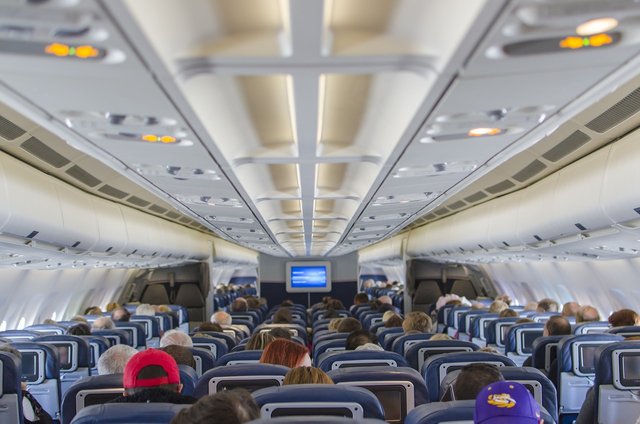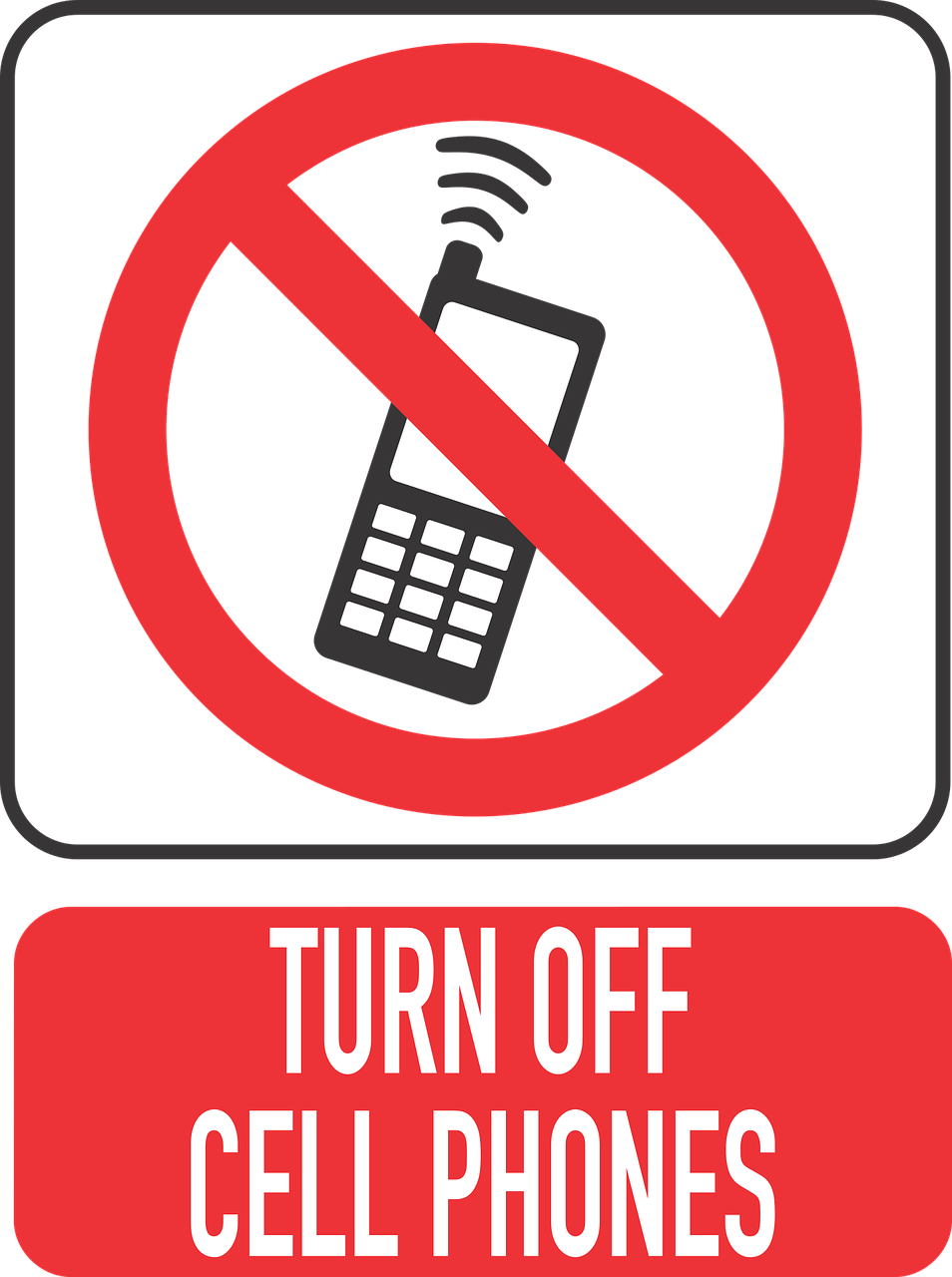Airplane Mode: Is There Any Danger to Use of Cell Phones in Flight?
The air-hostess voice came over the public address system in a pre-flight announcement.
"Ladies and Gentlemen, welcome to Flight P47428 heading to Abuja Nigeria. We are the second in line to take off, and we will be airborne in ten minutes time. We ask you to fasten your seatbelts secure all baggage in the overhead compartments and under your seat. Please turn off all personal electronic devices including cell phones and laptops. Thank you for choosing AirPeace Airlines."

[Pixabay Image]Source
The idea that streaming the Black Panther movies with the little 5.5-inch phone while onboard will bring down the Boeing 737 with its 140 plus passengers will always make one to ask more questions.
Who made these laws and for what purpose?
We will have to walk down the memory lane. In 1991 the Federal Communication Commision (FCC), the agency responsible for the regulation of communications by radio, satellite, tv, cable, etc. banned the use of cellphones and other wireless devices. This ban was because of fear of wireless interference on the aircrafts' electronic (avionics).
The radiowaves emissions from a cell phone may have an impact on the critical radio transmission between the ground networks ( the communication with air traffic controller and the pilot). The interface is crucial for pilot's navigation (to avoid running into thunderstorms), get landing clearing, and for taking off instructions.
Some airlines may allow you use the phone in the "airplane mode", which shuts down phone transmissions, others may insist on turning it off.
Failure to obey this instruction may get you arrested like a passenger flying in from Phoenix Arizona to El Paso in Texas, both in the USA, on September 5th, 2011.
The process is not just for the ordinary traveller as Alec Baldwin learnt. The 30 Rock TV celebrity found out in 2011 when he got kicked off the plane for refusing to turn off his iPhone as he was playing the game Words with Friends.
The proliferation of electronics especially handheld devices (DVD players, audio players, etc.) which many passengers are wont to take on with them on a flight, is now a new concern for the aviation safety sector.
Even though these devices may not transmit data over the air, there is a possibility they emit dangerous interfering signals which may likely meddle with the aeroplane's electronics such as its GPS (positioning system electronics).
But do cell phones pose such danger to the flight?
But cell phone's are not the only culprit. In 1999, a DVD player caused an instrument in the cockpit to indicate the plane was facing the opposite direction as it was in reality facing.
This claim may appear to be rare, but NASA's report gotten from different incidences of the portable electronic device causing anomalies in flight electronics show it may not be that rare. It shows out of 130 occurrences of aircraft affected system, between 1986 to 1999, 112 affected the navigation system of the aircraft.
The report could be seen on page 16, Table 10 of this 2001 report: Personal Electronic Devices and Their
Interference With Aircraft Systems.
But some school of thought have it that the modern aviation electronics are more interference-resistant compared to the old system avionics.
Guilt by Radiation?
The electromagnetic interference (EMI) is the culprit here.
The PEDs were operating frequencies ranges for some kilohertz in AM radios to about 400 MHz for personal computers. If the harmonics of these frequencies are taken into account, the result is a frequency which covers the entire range of both the aviation communication and navigation frequencies. The harmonics are the reoccurring multiple of an original wave pattern (fundamental frequency).
| Frequency | Aviation use |
|---|---|
| 10-14KHz | To determine aircraft position using ground-based transmitters |
| 108-118 MHz | Used for navigation |
| 328-335 MHz | Controls the glidescope system used in landings |
| 1GHz and above | Distance Measuring Equipment (DME) checks distance between aircraft and ground-based transponders |
| Still in 1GHz upwards freq range | Collision avoidance, global position system, weather rather functions, etc |
That implies when the radiated EMI are all taken into view, the electronic equipment aboard both commercial and military airplane is very likely at risk.
PED interference can be established via the antennas which are mounted on the fuselage and support different types of communication. Electromagnetic fields radiated by PEDs can be transmitted to the exterior of an aircraft through the fuselage apertures (windows). Furthermore, these RF fields can be received by communication or navigation-related antennas mounted on the skin of the fuselage. Source.
The shielding problem

Free image from the U.S. Air Force photo by Christopher Okula: Aircraft avionics being tested at an controlled electromagnetic environment shielded against radio frequency interference
Sometimes the wires from the antennas to the receivers pass through the aircraft's fuselage section following the inside of the aircraft skin (which is often less than a meter from a PED-wielding passenger).
The thin sheet fibreglass or other non-conducting material that is the shielding material offers little or no shielding between a PED EMI and the wiring.
Though the wires critical to the navigation are well shielded, most interference from portable emitting devices is often due to radiation that is picked up by the antennas.
Shielding also degrades over time; aluminium oxidises rapidly in air, this reduces its effectiveness as a proper shielding is dependent on a good grounding. That is, once the ground is not sufficient, the electrical resistance connection to ground increases.
A shield in mint condition is also susceptible to interference which can affect the aircraft's navigation or communication's systems.
The aluminium skin of the aircraft offers an outstanding amount of shielding, the holes on it in the form of windows provides a great escape route for radiation.
A More Modern Approach
Modern aeroplanes are said to be more hardened or immune to electromagnetic interference. This improvement prompted for a relaxed rule on the use of PEDs in some flights in the USA following the 2013 FAA upgraded rules.
The new rules made it possible for the use of particular PED (non-transmitting device) at below 10,000 feet. Before, you are only allowed to watch already downloaded games, movies, etc. without connecting to the internet at above 10,000 feet.
So you can only use the allowed devices at airplane mode at below 10,000 feet.
While many argued that the use of cell phone is much safer now with modern aircraft and its resistance to interference and wants to be allowed to make voice calls, Federal Communications Commission (FCC) Chairman Ajit Pai issued this statement dashing all hopes of that ever happening in April 2017.
“I stand with airline pilots, flight attendants, and America’s flying public against the FCC’s ill-conceived 2013 plan to allow people to make cellphone calls on planes. I do not believe that moving forward with this plan is in the public interest. Taking it off the table permanently will be a victory for Americans across the country who, like me, value a moment of quiet at 30,000 feet.” FCC
So, assuming it is all safe to make a phone call, I bet some passengers will like to have a quiet sleep without someone making an annoying call all through the 2 hours or more flight that you are forced to sit beside them :)
References
- NASA:Personal Electronic Devices and Their
Interference With Aircraft Systems - FAA Regulation on PED Ban
- Aviation Frequency Spectrum and its Uses
- Boeing on Interference from Electronic Device
- IEEE Spectrum article "Do Portable Electronics Endanger Flight?" by Tekla S. Perry and Linda Geppert
- FAA Allow Some PED Use at Below 10,000 Feet
If you write STEM (Science, Technology, Engineering, and Mathematics) related posts, consider joining #steemSTEM on discord here. If you are from Nigeria, you may want to include the #stemng tag in your post. You can visit this blog by @stemng for more details. You can also check this blog post by @steemstem here and this guidelines here for help on how to be a member of @steemstem. Please also check this blog post from @steemstem on proper use of images devoid of copyright issues here.



Nice one @greenrun. You are right, people do abuse and take undue advantage. Certain times I travelled as a passenger, I had forgotten to switch off my phone sometimes. It does interfare with the communication frequency and could affect the clarity of communication between pilots and traffic control unit. But then.....tech is changing
Tech is really changing, maybe with time we'd have a full interference-proof airplane. Then we'd just have to learn to cope with that annoying passenger who just couldn't stop talking on the phone about his or her new floor tiles :)
i always keep my phone off and enjoy the ride hahah but good to have information always thanks for posting this :)
That's the best way to go travel :)
"I'm getting confused now"
A friend of mine wanted to travel out of the country, so she collected songs and movies, so she can be entertaining herself while onboard.
Does this mean, she didn't make use of those materials?
And the flight was a 12-hour flight.
Some airlines may allow phone use on airplane mode at certain duration and altitudes during flight.
@greenrun I never knew why they use to say we shouldn't pick calls when it's raining until it happened to me. My God I was so scared that day, it happened that I picked a call and immediately there was a lightning, I felt the electric shock in my whole body, I was shivering for minutes before I recovered
I didn't know about the dangers of that. Thank you for your contribution.
thanks for this, my friends usually take selfies before traveling. i keep wondering why they are allowed to do this. i also see some celebrities do the same.
You can take selfies if phone is on airplane mode which most airlines allow. But like in most things some just don't obey the rule and still use their phones without activating airplane mode.
I agree with your stand because people always take undue advantages of things to abuse the privilege.
People will definitely abuse the privilege once calls are allowed assuming it'd be the safe thing to do.
this is really a great information for me, although I have never been on air but I will put in mind whenever I get opportuned to do so. Thanks for the information brother.
It is not as complex as it used to. You can book a flight in the comforts of your room.
Very educating! Most times, we accept rules without knowing why.
Thank you
Apparently if you do not turn your phone to
airplane mode, the sound can be picked up in the cockpit and can be irritating to the pilots' ears.
That's true, I once heard a pilot confirm that there's an interference on their communication which they find annoying.
I think the most dangerous part is the take off time, and whatever the interference the phones cause to the pilot and communicating station I don't know the details. However in some first class passengers are provided with Wi-Fi on board. So if my phone is on ✈ mode how am I supposed to surf the net. Once a plane is airborne you can even blog on Steemit and chat on discord lol
Nice write up and educative
Take offs and landings are usually the part of flight where great precision is required. It is also the dangerous part of flight where system malfunction could prove fatal. Thanks for joining the conversation.